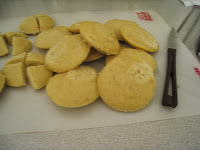Gaajar ka halwa is one of my favorite deserts! If not made properly, this dish can taste like sweetened boiled carrots. But if made with little effort (and love) this can be a very tasty and flavorful desert. Some measurements I have given here are approximates because it depends on your taste especially the sweetness. Although I believe if you are making a desert then make it sweet - don't make it such that it seems like a desert but its not really sweet.....
One word of warning - since I find this desert a little labor intensive I make it in large quantity and freeze half of it for later.
Ingredients
- 5 lbs carrots
- 4-5 cups of milk (1% or 2%)
- One 8-10 oz can condensed milk (sweetened/low fat is what I used)
- One and half cup sugar
- Half cup or more ghee
- Raisins, cashews to garnish
- Wash and grate the carrots. (I love my food processor for this reason!)
- Add the carrots to a large stir frying pan and start heating. Add the milk.
- Cook the carrots in the milk. This requires constant stirring otherwise the milk might stick to the bottom of the pan. I love my non stick pan for that reason, no sticking at this step!
- Keep stirring and cooking until almost all the water has evaporated. The picture shows that the milk is still not yet evaporated. See the bubbles?
- Once the carrots start looking a little dry, add the condensed milk which melts in the carrots to make them watery again. Keep stirring and evaporating the water.
- Add the sugar at this point. Again, sugar melts to give water, so keep stirring.
- I start adding the ghee a little bit at a time at this point.
- Keep stirring and adding ghee until nice and thick consistency. Taste at this point to make sure the sugar is at your "bliss point".
- Keep stirring (bhuno) the halwa; it will turn reddish as it is getting done. At one point the aroma of the halwa will tell you the halwa is ready.
- Add the garnishes now and stir in to mix.

The nice thing about this halwa is that since its cooked well it lasts a while, it can be eaten cold or warm (I prefer hot). The more ghee you add in the last steps the richer it becomes and the better it looks. But just adding ghee without the stirring (bhuning) is not going to give flavor.
One other thing I have to try at some point is to substitute the condensed milk for khoya. I am sure it will be even more delicious!











